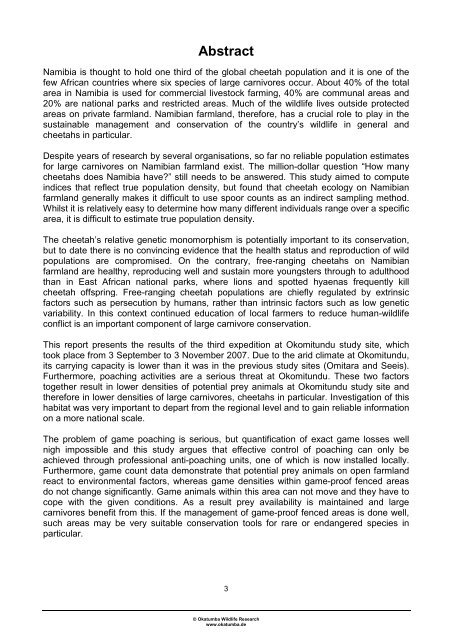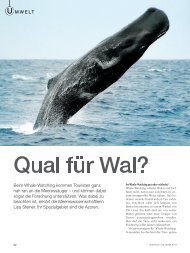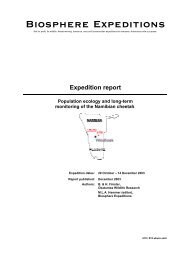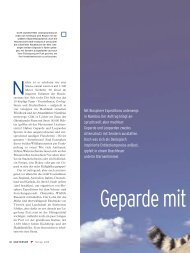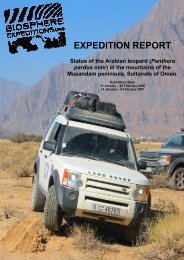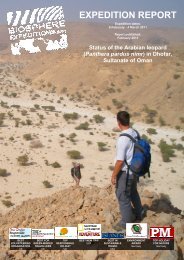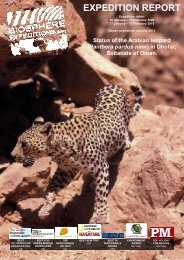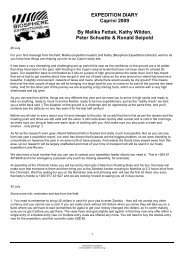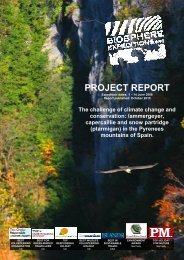EXPEDITION REPORT - Biosphere Expeditions
EXPEDITION REPORT - Biosphere Expeditions
EXPEDITION REPORT - Biosphere Expeditions
You also want an ePaper? Increase the reach of your titles
YUMPU automatically turns print PDFs into web optimized ePapers that Google loves.
Abstract<br />
Namibia is thought to hold one third of the global cheetah population and it is one of the<br />
few African countries where six species of large carnivores occur. About 40% of the total<br />
area in Namibia is used for commercial livestock farming, 40% are communal areas and<br />
20% are national parks and restricted areas. Much of the wildlife lives outside protected<br />
areas on private farmland. Namibian farmland, therefore, has a crucial role to play in the<br />
sustainable management and conservation of the country’s wildlife in general and<br />
cheetahs in particular.<br />
Despite years of research by several organisations, so far no reliable population estimates<br />
for large carnivores on Namibian farmland exist. The million-dollar question “How many<br />
cheetahs does Namibia have?” still needs to be answered. This study aimed to compute<br />
indices that reflect true population density, but found that cheetah ecology on Namibian<br />
farmland generally makes it difficult to use spoor counts as an indirect sampling method.<br />
Whilst it is relatively easy to determine how many different individuals range over a specific<br />
area, it is difficult to estimate true population density.<br />
The cheetah’s relative genetic monomorphism is potentially important to its conservation,<br />
but to date there is no convincing evidence that the health status and reproduction of wild<br />
populations are compromised. On the contrary, free-ranging cheetahs on Namibian<br />
farmland are healthy, reproducing well and sustain more youngsters through to adulthood<br />
than in East African national parks, where lions and spotted hyaenas frequently kill<br />
cheetah offspring. Free-ranging cheetah populations are chiefly regulated by extrinsic<br />
factors such as persecution by humans, rather than intrinsic factors such as low genetic<br />
variability. In this context continued education of local farmers to reduce human-wildlife<br />
conflict is an important component of large carnivore conservation.<br />
This report presents the results of the third expedition at Okomitundu study site, which<br />
took place from 3 September to 3 November 2007. Due to the arid climate at Okomitundu,<br />
its carrying capacity is lower than it was in the previous study sites (Omitara and Seeis).<br />
Furthermore, poaching activities are a serious threat at Okomitundu. These two factors<br />
together result in lower densities of potential prey animals at Okomitundu study site and<br />
therefore in lower densities of large carnivores, cheetahs in particular. Investigation of this<br />
habitat was very important to depart from the regional level and to gain reliable information<br />
on a more national scale.<br />
The problem of game poaching is serious, but quantification of exact game losses well<br />
nigh impossible and this study argues that effective control of poaching can only be<br />
achieved through professional anti-poaching units, one of which is now installed locally.<br />
Furthermore, game count data demonstrate that potential prey animals on open farmland<br />
react to environmental factors, whereas game densities within game-proof fenced areas<br />
do not change significantly. Game animals within this area can not move and they have to<br />
cope with the given conditions. As a result prey availability is maintained and large<br />
carnivores benefit from this. If the management of game-proof fenced areas is done well,<br />
such areas may be very suitable conservation tools for rare or endangered species in<br />
particular.<br />
3<br />
� Okatumba Wildlife Research<br />
www.okatumba.de


